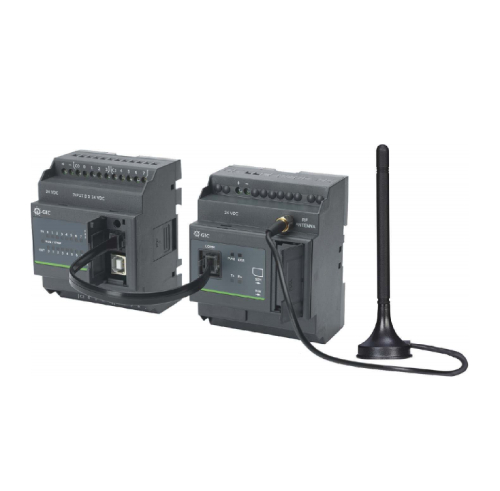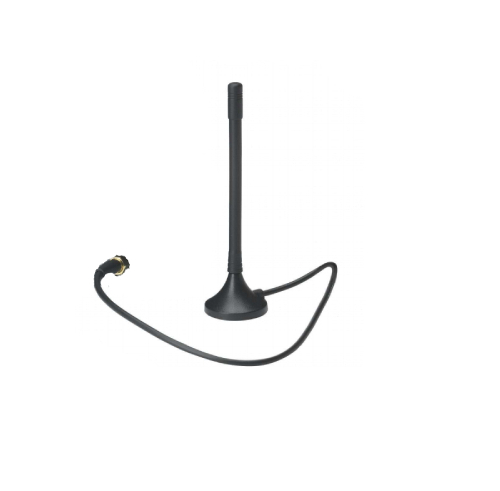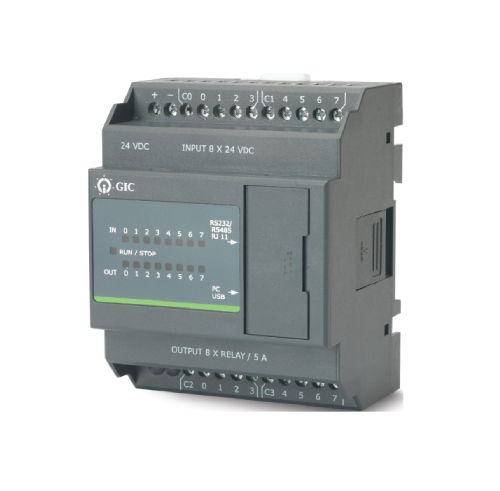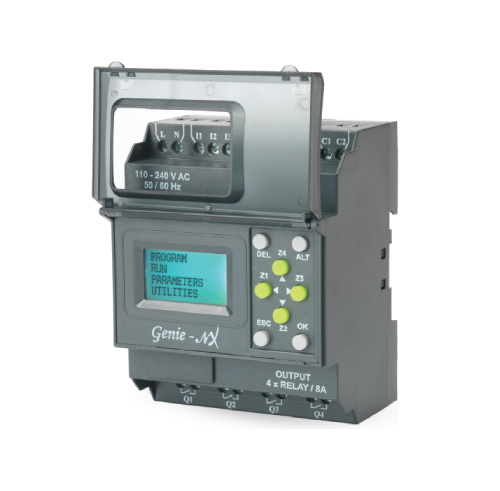A Programmable Logic Controller (PLC) is a versatile device used to monitor input signals and make decisions based on programmed logic to control various outputs to automate machines and processes. PLCs are designed to provide reliable and efficient control in various applications, from residential and commercial settings to industrial environments.
With their compact design, flexible configuration, and powerful instruction sets, PLCs offer users the ability to implement a wide range of control functions. They can perform tasks such as Boolean logic operations, counting, timing, complex mathematical operations, and communication with other intelligent devices. This makes PLCs a perfect solution for controlling diverse applications.
PLCs offer a robust framework with features like sequential access control, user-friendly programming interfaces, timers, counters, and secure control capabilities. They can be easily integrated into various systems and environments, providing enhanced management and automation capabilities. Whether it's optimizing PLC manufacturer processes or managing complex tasks, we provide the necessary control and reliability.
Supply Voltage +
Mode +
Mounting +
Relay +
No. Of Programs +
Display +
Power Reserve +
Clock Accuracy +
Pre-Programmed +
Accessories +
Product visibility +
Analog Input +
Base/Ext +
Bazel type +
Center Distance +
Clock +
Control Action +
Display with & without +
Input/Output +
No. of digits +
No. of set points +
Output +
Output 1 +
Output 2 +
Output 3 +
Product Type +
Read Out +
Register +
RS485 Communication +
Sensor Input +
Size +
Termination +
Contact +
Delay +
Enclosure Design +
Function +
Input Voltage +
Output Current +
Output Voltage +
Power +
Relay Output +
Supply +
Timing Range +
Variant +
Alarm Output +
Analog Output +
Auto Reset time +
Auxiliary Supply +
CBCT Size +
Colour +
Current Range +
Digital Display +
Digital Input +
Digital Output +
Display Colour +
High Speed Inputs +
Input Signal +
LCD Display +
Leakage Current +
Module +
Neutral Loss +
Output Signal +
Over Frequency +
Over Voltage +
Phase Asymmetry +
Phase Loss +
Phase Sequence +
Reset +
Sensor Supply +
Series +
Settable Off Delay +
Settable On Delay +
System +
Transistor Output +
Under Frequency +
Under Voltage +
Voltage +
Advantages of Using PLCs
Here are the advantages of using Programmable Logic Controllers (PLCs) in industrial automation and control systems:
Enhanced Control
PLCs offer precise control over industrial processes and machinery, allowing for accurate monitoring and adjustment of variables such as temperature, pressure, and speed.
Flexibility
They provide a high level of flexibility in programming, allowing users to easily modify and adapt control logic to meet changing process requirements or optimize performance.
Reliability
We have designed it to operate in demanding industrial environments, with robust hardware and software that ensure reliable and continuous operation. This results in reduced downtime and improved overall system reliability.
Scalability
PLC systems can be easily expanded or upgraded by adding additional input/output modules or incorporating advanced features, making them suitable for both small-scale and large-scale applications.
Faster Response
They execute control tasks in real-time, enabling quick response to changes in input signals and efficient control of output devices. This is critical in applications where rapid decision-making and precise control are necessary.
Easy Troubleshooting
We provide diagnostic tools and troubleshooting capabilities, simplifying the process of identifying and resolving issues within the control system. This helps minimize downtime and improve maintenance efficiency.
Integration with Other Systems
They also support seamless integration with various devices and systems, including sensors, annunciators, human-machine interfaces (HMIs), and supervisory control and data acquisition (SCADA) systems. This enables efficient data exchange and coordination between different components of an automated system.
By leveraging the advantages of PLC automation, industries can achieve improved process control, increased productivity, reduced costs, and enhanced safety in their operations.
How a Programmable Logic Controller Works
A PLC operates as an input-output system, with each unit accepting inputs and controlling outputs. The key element that connects the inputs and outputs is logic programming, which occurs within the CPU of the PLC.
Input Monitoring
The PLC automation constantly monitors the inputs, which can be discrete (on/off) or analogue signals. Inputs can come from a wide range of devices such as IoT devices, robots, safety sensors, and human-machine interfaces (HMI). The PLC gathers this input data and sends it to the CPU for processing.
Logic Programming
The heart of a PLC lies in its CPU, which is equipped with a microprocessor. Engineers and technicians program the Programmable Logic Controller’s CPU to recognize specific conditions, values, and rules. The CPU continuously checks the state of variables and executes programmed instructions based on defined conditions. This flexibility allows for the implementation of a wide variety of designs and functions.
Output Control
Based on the programmed logic, the PLC exerts control over various devices connected to its outputs. These devices can include switches, motor starters, smart relays, and more. By controlling these outputs, the PLC manufacturer can influence mechanical processes, enabling the operation of machines and systems. Moreover, PLCs can be linked in a chain, allowing the output signals of one to serve as inputs for another, facilitating complex system integration.
Factors to Consider When Choosing a PLC
When it comes to specifying a PLC automation model for your application, several factors come into play. These key considerations will significantly influence your decision-making process:
Electrical Capacity
The electrical capacity of a PLC refers to its ability to handle the required voltage and current levels of the connected devices. It is crucial to ensure that the PLC’s electrical capacity aligns with the power requirements of your application to prevent overloading or insufficient power supply.
Processing Speed
The processing speed of a PLC determines how quickly it can execute program instructions and respond to input signals. Depending on the complexity and speed requirements of your application, selecting a PLC with an appropriate processing speed is essential to ensure efficient and timely control operations.
Compatibility
Consider the compatibility of the PLC automation with your existing systems, equipment, and software. Compatibility ensures seamless integration, communication, and data exchange between the PLC and other components of your automation system.
Temperature Tolerance
The operating environment plays a significant role in selecting a suitable PLC. Temperature tolerance refers to the PLC’s ability to function reliably in specific temperature ranges. Ensure that the PLC can withstand the ambient temperature conditions of your application environment, especially if it involves extreme temperatures or challenging industrial settings.
Memory
PLCs require memory to store program instructions, data, and configuration settings. Evaluate the memory capacity of the nano PLC to accommodate your program size and data storage requirements. Sufficient memory capacity ensures smooth operation and allows for future expansion if needed.
Connectivity
Consider the connectivity options provided by the PLC automation, including digital and analog input/output (I/O) ports, communication protocols, and networking capabilities. Choose a low cost PLC that offers the required connectivity features to interface with sensors, actuators, other devices, and communication networks.
Analog I/O
If your application involves processing analogue signals, such as voltage or current levels, ensure that the low cost PLC supports the required number of analogue input and output channels with adequate resolution and accuracy.
As a prominent PLC manufacturer, GIC has established a global presence and offers a comprehensive range of smart relays and mini PLCs. These devices are designed to withstand harsh and challenging conditions while providing greater control and efficiency in industrial applications. GIC’s commitment to quality and innovation ensures that its PLCs meet the diverse automation needs of industries worldwide.
Some of the features include
Smart Relay Genie-Nx
- Supports up to 48 I/Os (32 Digital Inputs & 16 Digital Outputs)
- 250 lines of ladder programming
- 16 soft text messages, Time Switches, Compare Counters, Timers, Counters & 12 Analog functions, 4 Hour Meters
- DST Feature Available
- Backlit LCD Screen for display & modification of pre-selected parameters of functional blocks, viewing I/O status and programming on the device
- PC software for programming, online & offline simulation, documentation & printing
Mini PLC PL-100
- Supports up to 112 IOs
- Relay Base & MOSFET Low Side Base modules
- Stacking using FRC cable up to maximum 6 Expansion Modules
- Isolated Digital Inputs with sourcing & sinking capability
- Isolated Digital Transistorized Outputs (Low Side and High side driver)
- High-Speed Inputs – Single / Quadrature (1x/2x/4x)
- High-speed outputs (PTO / PWM / S-Profile)
- Analog Voltage/Current Inputs and Outputs of 0-10 V / 4-20 mA
- PC Software for programming, online & offline simulation
- Standard RS232/RS485 port with RJ11 for HMI/SCADA Interface
- Mini PLC has Modbus RTU support
- 128 Weekly, Monthly & Yearly Time Switches each
- 1Multiple timers, counters including retentive counters, Hour meters & many more function blocks
Frequently Asked Questions
A programmable logic controller (PLC) is an industrial computer that has been ruggedized and adapted for the control of manufacturing processes, such as assembly lines, machines, robotic devices, or any activity that requires high reliability, ease of programming, and process fault diagnosis.
The different types of Programmable Logic Controllers are Relay Output PLCs, Transistor Output PLCs, and Triac Output PLCs.
PLC programs operate in cycles. First, the PLC detects the state of all input devices that are connected to it. The PLC executes the user-created program, using the state of the inputs to determine the state that the outputs should be changed to. The PLC then changes the output signals to each corresponding device.
The GIC’s PLC is used for the following main applications :
- Machine Automation
- Process Automation
- Robotic Automation
- Agriculture Automation
- Building Automation
Yes, In industrial automation PLC is the most important device.
The factors that you must consider are
- Input supply of PLC
- The number of inputs/outputs and their signal types.
- Communication Interface.
- Application memory size.
GIC PLCs are designed to operate in harsh industrial environments, with features such as built-in protection against electrical noise and temperature extremes. This makes them more reliable & durable than traditional relay-based control systems.
PLC is an industrial computer that monitors inputs and outputs to make decisions based on the program stored in the PLC’s memory. The use of PLCs helps to reduce human decision-making efforts to gain higher efficiency.
Basically in the process industry, most of the plants have more Analog & Digital signals. In those plants, PLC reduces the plant parameters monitoring & system controlling time, Increases the safety of plant & labour, increases the quality of the product & reduces the cost of production.
Yes, GIC PLC supports Bidirectional digital input, Transistor/Smart Relay base Digital output, Analog voltage/current inputs & outputs of 0-10V/4-20mA




